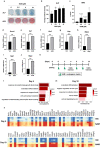Nicotinamide enhances osteoblast differentiation through activation of the mitochondrial antioxidant defense system
- PMID: 37464093
- PMCID: PMC10393969
- DOI: 10.1038/s12276-023-01041-w
Nicotinamide enhances osteoblast differentiation through activation of the mitochondrial antioxidant defense system
Abstract
Although the normal physiological level of oxidative stress is beneficial for maintaining bone homeostasis, imbalance between reactive oxygen species (ROS) production and antioxidant defense can cause various bone diseases. The purpose of this study was to determine whether nicotinamide (NAM), an NAD+ precursor, can support the maintenance of bone homeostasis by regulating osteoblasts. Here, we found that NAM enhances osteoblast differentiation and mitochondrial metabolism. NAM increases the expression of antioxidant enzymes, which is due to increased FOXO3A transcriptional activity via SIRT3 activation. NAM has not only a preventive effect against weak and chronic oxidative stress but also a therapeutic effect against strong and acute exposure to H2O2 in osteoblast differentiation. Collectively, the results indicate that NAM increases mitochondrial biogenesis and antioxidant enzyme expression through activation of the SIRT3-FOXO3A axis, which consequently enhances osteoblast differentiation. These results suggest that NAM could be a potential preventive or therapeutic agent for bone diseases caused by ROS.
© 2023. The Author(s).
Conflict of interest statement
The authors declare no competing interests.
Figures






References
-
- Wilson C. Oxidative stress and osteoporosis. Nat. Rev. Endocrinol. 2014;10:3–3. - PubMed
Publication types
MeSH terms
Substances
LinkOut - more resources
Full Text Sources
Medical
Research Materials

